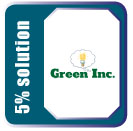 By Liz Galst
By Liz Galst
Last month, Tami and Randy Wilson of Harrisburg, Pa., may well have become the first homeowners to ever sell a carbon credit they’d generated at home. The family saved one metric ton of carbon by reducing their energy use and installing solar panels on their roof.
The deal, which garnered the Wilsons $17.20, was brokered by My Emissions Exchange, a carbon-credit aggregator in White Plains, and the credit was sold to Molten Metal Equipment Innovations, an equipment manufacturer in nearby Ohio, which bought it to offset its own emissions.
My Emissions Exchange, which earns a commission on the brokerage of the carbon credits, said it hopes to enroll a million households in its emissions reduction program. Roughly 1,800 homeowners have registered since the company’s debut in September 2009.
Doing Well by Doing Good
 “What we’re trying to do is to get enough people so we have a steady stream of credits,†said Paul Herrgesell, the company’s project manager.
“What we’re trying to do is to get enough people so we have a steady stream of credits,†said Paul Herrgesell, the company’s project manager.
Homes account for about one-sixth of total greenhouse gas emissions in the United States and are notorious energy hogs. So the market might be ripe for such household-based emissions reductions schemes, said Mick Womersley, a climate policy expert at Unity College, in Unity, ME.
“If you can demonstrate verification, there’s certainly institutions and companies that want to buy these credits,†Mr. Womersley said.
In 2006, Mr. Womersley helped broker a deal in which Maine’s housing authority, MaineHousing, sold carbon reductions achieved through energy-efficiency retrofitting in the state’s low-income housing stock to Unity College to offset the college’s travel emissions.
Myemissionsexchange.com works by getting renters and owners — as well as any large building or small business that is billed through a single meter — to enter their utility and heating bills into its Web-enabled database. Participants must upload or mail in their bills for verification.
“On the voluntary carbon market, the issue of quality is an important one,†Mr. Herrgesell said. Current energy use and emissions are measured against those of the previous 12 months.
Trend?
The voluntary carbon market topped $704 million in 2008, and just how much of a role individual households can play in it remains an open question.
Already, homeowners with solar panels play a small, but increasingly active part in markets for renewable energy credits in states like New Jersey, Maryland and Pennsylvania.
“The number of homeowners in our program is growing exponentially,†said Michael Winka, the director of the Office of Clean Energy at the New Jersey Board of Public Utilities, which oversees homeowner sales of solar renewable energy credits in the state. “The typical homeowner can make more than $3,200 a year,†Mr. Winka said.
The average participant at My Emissions Exchange, by comparison, is expected to earn just $40 to $60 a year.
But Mr. Herrgesell said the money saved from reduced energy use — $500 to $600 for some participants — is a strong incentive, despite the time required to enter data and upload utility bills to the company’s Web site.
Mr. Womersley of Unity College said he thought even that is a minor hurdle for some potential participants. “I wouldn’t underestimate how much time young people are prepared to spend doing geeky stuff on computers,†he said.
Liz Galst writes for the Green Inc. blog at the New York Times. bit.ly/9oy4H9
